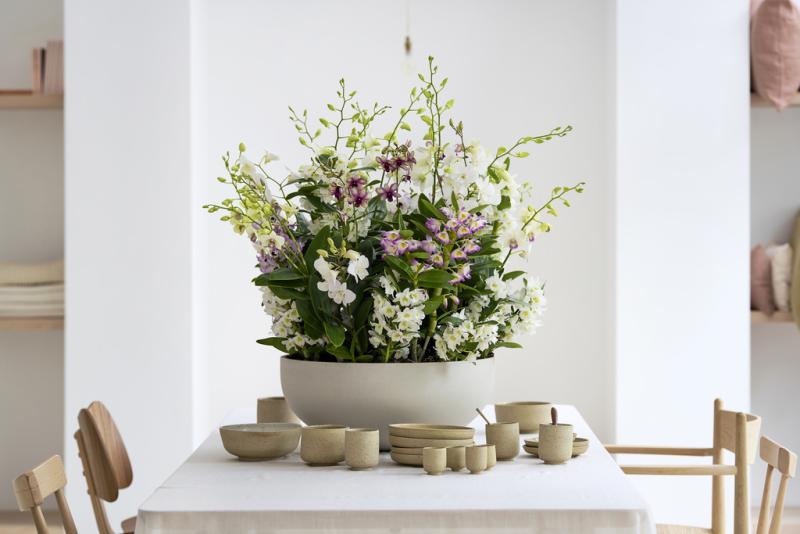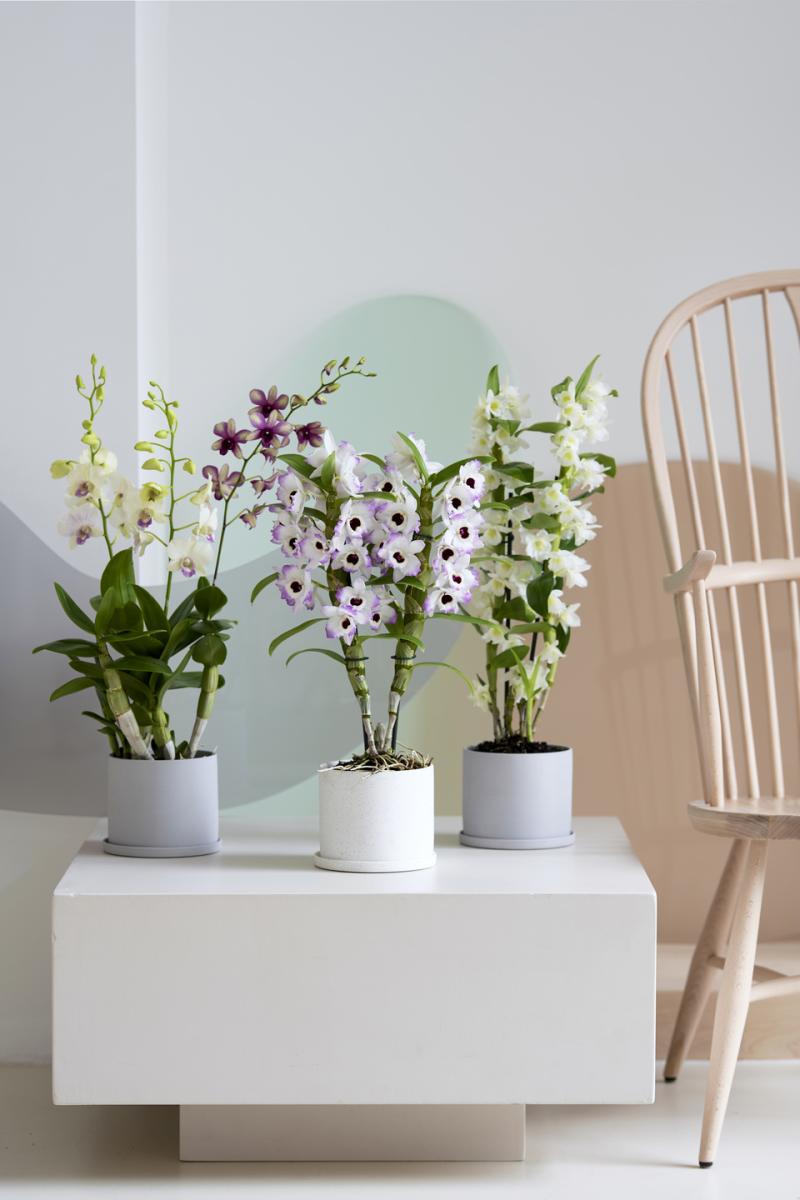Dendrobium: Houseplant of the Month March 2020
The story of Dendrobium
Dendrobium features a sturdy stem with scales and leaves from which emerges a candle of idiosyncratic flowers, which may also have a light scent depending on the variety. The structure means that this orchid has an attractive full look: it’s a houseplant that really does offer value for money.
Dendrobium is a popular orchid from the same family as Phalaenopsis, Cambria and Cymbidium. All these orchids are characterised by the classic structure of the flower with five sepals and petals, an attractive lip and a ‘column’.
In the wild Dendrobium often grows as an epiphytic orchid on rocks or in trees without drawing nutrients from them. The roots obtain those nutrients from the air. As a pot orchid they are therefore planted in well-drained, airy soil or bark. The best-known is Dendrobium nobile, a torch of flowers with beautiful patterns.
Origin
Dendrobium is a popular genus from the Orchidaceae family. Around 1200 Dendrobium species grow in the wild across a fairly large territory which is shaped like an enormous triangle, from the Himalayas and southern Japan to Australia and New Zealand. In the wild Dendrobium often grows as an epiphytic orchid on rocks or in trees without drawing nutrients from them.
Dendrobium assortment
There are two types of Dendrobium orchid: the compactum and the Phalaenopsis hybrids. The compactum species often have multiple canes (fully-grown pseudobulbs), and therefore also multiple stems with smaller flowers (1 to 7 cm). The best-known species is Dendrobium nobile, a torch of flowers with beautiful patterns. There are a number of series of this, of which the Star Class is the best-known. The Phalaenopsis hybrids have one or two stems with larger flowers (7 cm or bigger). The best-known of this is the Sa-Nook series in many different colours ranging from yellow, green and white through to purple, pink and bi-coloured. The lip colour can also vary. There are also a number of very natural-looking botanical species: D. kingianum x biggibum and D. Berry Oda.

- When buying Dendrobium it is important to pay attention to the ripeness of the plants. With D. nobile this can range from showing colour (unripe) through to all flowers open (ripe). With the other species it can range from 1 bud open through to all flowers open with at least 1 closed bud.
- When buying Dendrobium it’s also important to consider the proportion between the pot size, the plant height with the length of the stems and the number of stems per plant. The number of flowers and buds per stem also determines the price.
- Naturally the choice will be largely determined by the colour of the flowers. We are increasingly also seeing colour-modified Dendrobiums, particularly D. nobile.
- The plant should be free of pests and disease when purchased. The flowers sometimes suffer from botrytis (= blight or grey mould), a fungus that greatly diminishes the decorative value. The plants must also be sufficiently damp (not wet) in order to prevent the canes (pseudobulbs) and buds from drying out.
- Like many orchids, Dendrobium is sensitive to ethylene damage which causes bud drop or dried buds. Ethylene is an ageing hormone that encourages bud drop, the failure of the flowers to open and accelerated ageing. Ventilation during shipping or at the point of sale is important, and make sure that the plant is not placed next to sources of ethylene such as fruit.
- The plant may have yellow leaves because it has been kept too wet or too dry.
- Pests such as scale insects and mealybug sometimes also occur and are a challenge to eradicate, both at the point of sale and for the consumer.
- The recommended storage and shipping temperature is 15 °C. Avoid draughts and wind. Cold damage caused by temperatures that are too low should be avoided, particularly in the winter months, when the plants should be protected in a box or sleeve.
Care tips for customers
- Dendrobium prefers a room temperature of 18-25 °C.
- The plant requires a light position. The plant can tolerate direct sunlight in the winter months. The sun is too bright from early April to early October, and the plant should not be placed directly in the sun during that period. The plant does not get any direct sunlight in its places of origin, the tropical rainforest.
- The plant does not need a lot of water - once a week is enough, but do not let it dry out completely either. Too much water is more damaging than too little, and results in yellow leaves.
- Rest the plant for 6-8 weeks after flowering and keep it drier and cooler at 15 °C in a bedroom or utility room, for example. The plant will respond to the low temperature by producing buds as a survival strategy. The plant does not need much water during this cool period. Once the new buds are visible the plant can be given the normal care again, so that it can show off its fabulous flowers once more.
- Never place Dendrobium near sources of ethylene such as fruit and vegetables. This will cause bud drop, the failure of buds to open or accelerated ageing.
Sales and display tips
Dendrobium fits with the interiors trend in which the home is furnished in such a way that it appears to absorb and soften impacts from the outside. Choose pots in colours such as nude, powder pink, grey-green with some dark green as a contrast and matt surfaces to create a calming effect. Place the orchids in ceramic bowls, matt glass pots or in a pot carved out of pink salt. Additions such as feathers, tulle, photographs and paintings with mist themes help reinforce the feeling. The characteristic vertical growth habit also makes the plant ideal for an arrangement as a flowering screen.
Dendrobium imagesYou can download and use the images below free of charge if you credit Thejoyofplants.co.uk.
Instagram: @thejoyofplants
Facebook: @thejoyofplants
Twitter: @thejoyofplants
For more information about the 2019 Houseplants of the Month selection, click here.
Dendrobium poster
You can download the poster using the link below.










